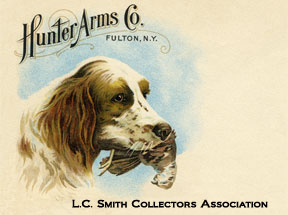|

Sanderson Steel was started in Sheffield, England in 1776 and Sanderson Bros. & Newbold Ltd. purchased a small crucible mill in Syracuse in 1876. Their Crown steel was used for the Pigeon Grade in 1893, A1 in 1894, the No. 3 about 1895, and the No. 2 in 1898.
Nitro steel was introduced in 1898 for the No. 3 and Pigeon and later the No. 4 and No. 5.
Armor was used for the 00 and Royal on hammer guns starting in 1898.
Sanderson Steel’s brand name was "Sanderson Bros. & Co." and was one of 13 companies that formed Crucible Steel Co. in 1901.
Halcomb Steel Co. opened in Syracuse in 1904, and L.C. Smith was Chairman of the Board of Directors. Halcomb supplied London steel for 0 grades and Royal steel for the hammer guns starting in 1907. Crucible Steel bought Halcomb in 1911.
There can be no doubt that some (if not all pre-WW1) fluid steel 'rough forged tubes' were sourced in Belgium, and Sanderson/Crucible may have only acted as the importers.
Until strength testing and composition analysis is conducted on the many named steel barrels, we cannot know if there is any difference between them, and the fluid steel used by the other U.S. makers.
PRE-1913 FLUID STEEL BARRELS:
F grade Hammer Gun - Royal,
00 - Armor,
0 - London,
1 - Special,
2 - Crown,
3 - Nitro-3,
Pigeon - Crown on introduction in 1893 then Nitro-P,
4 - Nitro-4,
5 - Nitro-5,
Monogram, A2, A3 - Whitworth (first offered in 1895).
POST-1913 BARRELS:
F grade Hammer Gun - Royal,
Field - Armor,
Ideal & Skeet - London,
Trap - Crown,
Specialty - Nitro,
Eagle - Nitro-4,
Crown - Nitro-5,
Monogram - Whitworth & Monogram (Crucible 1918-1922),
Premier - Whitworth & Premier (Crucible),
Deluxe - Whitworth & Deluxe (Crucible).
For more information see:
http://www.picturetrail.com/sfx/album/view/19686599
http://docs.google.com/a/damascusknowledge.com/document/pub?id=17ixogftgITEblNUWtmFBv96ZvgjK6eFell8GsAWd-KI
COPYRIGHT
L.C. Smith Collectors
Association 2015
Updated 02/17/2015
|

